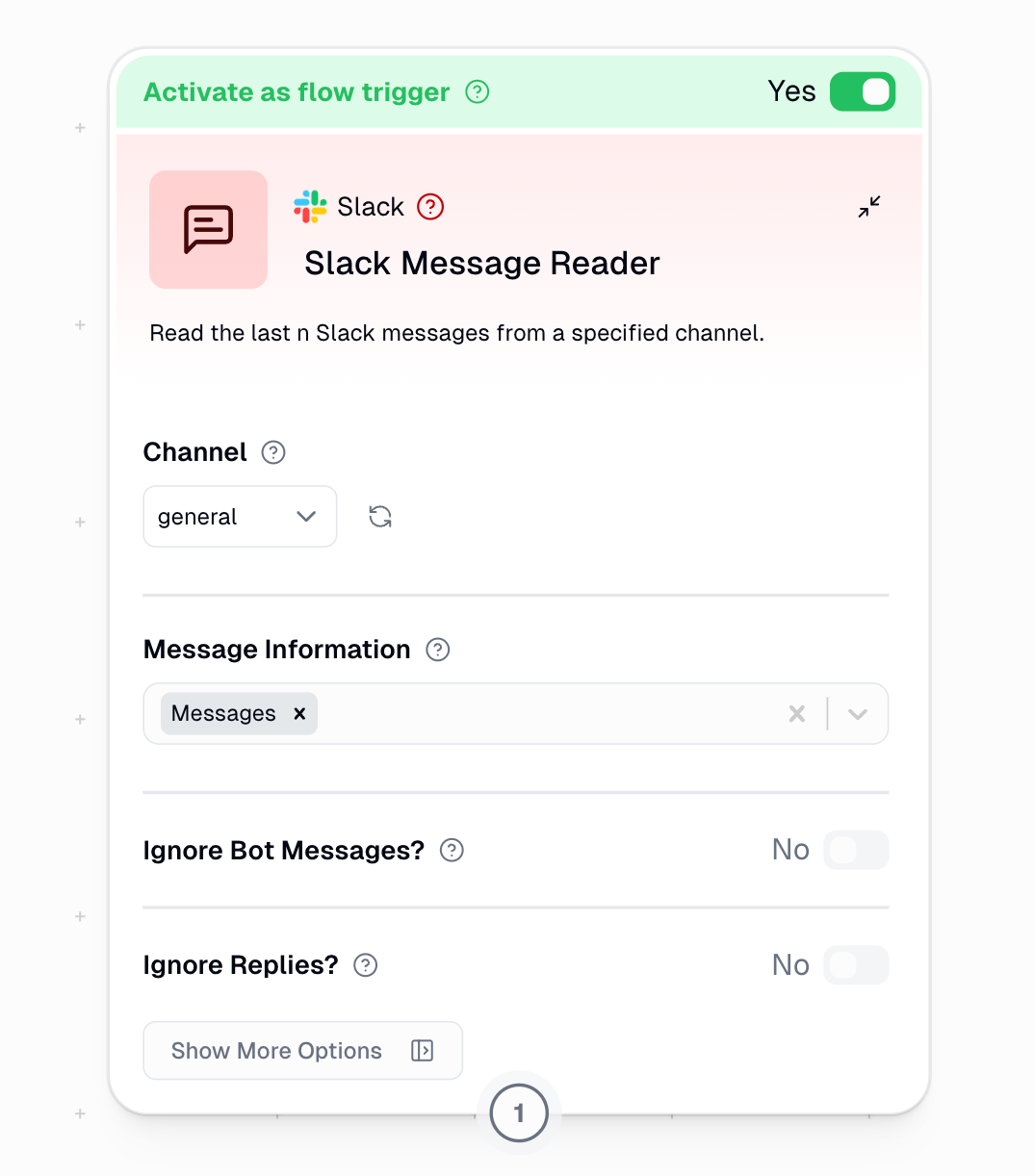Channel Access Requirements
To read messages from any Slack channel (public or private), you must be a member of that channel. Channels you’re not a member of won’t appear in the dropdown.
1
Authenticate with Slack
Go to the Credentials page and connect your Slack workspace.
2
Join the Channel
Make sure you’re a member of the channel you want to read from. Private channels require an invite from an existing member.
3
Select the Channel
The channel will now appear in the dropdown menu in the node configuration.
Node Configuration
Message Information Options
Select which data elements you want to retrieve from Slack messages:| Output | Description |
|---|---|
| Messages | The actual text content of messages, including formatted text, emojis, and timestamps. If “Read Full Thread” is enabled, this includes replies. |
| Thread IDs | Unique identifiers for each message thread. Useful for replying to specific threads using the Slack Message Sender node. |
| Thread Links | Direct URLs to specific message threads in Slack for quick access to original discussions. |
| Attachment Names | Files shared in messages including documents, images, and videos. |
| Sender Names | Names of users who sent the messages. Useful for filtering or routing based on sender. |
| Channel Name | The name of the channel where messages were posted. |
| Channel ID | The unique identifier for the Slack channel, useful for API integrations. |
| Date | The datetime in UTC when the message was sent. |
Basic Settings
- Channel: Select target Slack channel
- Message Count: Number of messages to fetch (default: 10)
- Set to 1 for single message processing
- The output in this case is in the
Textformat
- The output in this case is in the
- Higher numbers return lists of messages
- The output in this case is in the
Listformat
- The output in this case is in the
- Set to 1 for single message processing
Optional Settings
Date Range Filtering
Date Range Filtering
Filter messages by a specific time period:
- Use Dates?: Enable to filter messages by time period
- Date Range: Choose from preset ranges (Last 24 Hours, Last Week, Last Month, Last 3 Months, Last 6 Months)
- Use Exact Dates?: Toggle to specify custom date ranges with precise Start and End dates
Thread Settings
Thread Settings
- Read Full Thread: When enabled, retrieves the main message plus all replies in the thread, including participant information. Perfect for tracking complete conversations or support threads.
Bot Message Handling
Bot Message Handling
- Ignore Bot Messages: When enabled, skips messages from all Slack apps and integrations, processing only messages from human users. Useful when multiple automations are active in the channel.
Configure Inputs
Make these parameters dynamic by enabling them in “Configure Inputs”:- Channel: Switch channels based on conditions or other node outputs
- Message Count: Adjust the volume of messages processed based on workflow needs
- Start Date: Dynamically adjust your date window (requires “Use Dates?” enabled)
- End Date: Pair with Start Date for dynamic date ranges
Trigger Mode
The Slack Message Reader can function as a trigger to start your flow when new messages arrive.
Trigger Settings
Ignore Bot Messages?
Ignore Bot Messages?
- No (Default): All messages trigger your flow, including those from bots and integrations
- Yes (Recommended): Only human-generated messages trigger your flow
- Prevents trigger loops where your flow output triggers itself
- Reduces noise from system notifications
- Essential when your flow posts back to the same channel
Ignore Replies?
Ignore Replies?
- No (Default): All messages trigger your flow, including replies in threads
- Best for monitoring ongoing conversations
- Useful for support bots tracking entire discussions
- Yes: Only new standalone messages trigger your flow
- Replies within conversation threads are ignored
- Focuses automation on new topics only
Recommended Trigger Settings
For most automations:- Ignore Bot Messages: Yes - Prevents trigger loops and focuses on human communications
- Ignore Replies: No - Captures all relevant communications including thread discussions
Note: When building response bots, always enable “Ignore Bot Messages” to prevent infinite loops where your bot responds to its own messages.
Example Workflows
Customer Support Monitor
- Channel: #support
- Read Full Thread: Yes
- Ignore Bot Messages: No
- Purpose: Analyze and document support conversations
Team Updates Trigger
- Channel: #team-updates
- Message Count: 1
- Ignore Bot Messages: Yes
- Purpose: Send important updates to stakeholders
Resource Archival
- Channel: #resources
- Read Full Thread: Yes
- Date Range: Last 7 days
- Purpose: Archive shared resources and documentation
Weekly Channel Report
- Use Dates?: Yes
- Use Exact Dates?: Yes
- Start Date: Connected to Current DateTime with -7 days modifier
- End Date: Connected to Current DateTime
- Purpose: Generate weekly summary reports of channel activity
Output Format
The output format changes based on Message Count:Multiple Messages (Count > 1)
Returns lists:- Messages: [“Hello”, “How are you”]
- Thread IDs: [“123”, “456”]
- Thread Links: [“https://company.slack.com/archives/C123/p456”, “https://company.slack.com/archives/C123/p789”]
- Sender Names: [“Alice”, “Bob”]
- Channel Name: [“general”, “general”]
- Channel ID: [“C123456”, “C123456”]
Single Message (Count = 1)
Returns single values [text]:- Message: “Hello”
- Thread ID: “123”
- Thread Link: “https://company.slack.com/archives/C123/p456”
- Sender Name: “Alice”
- Channel Name: “general”
- Channel ID: “C123456”
Important Considerations
- Authentication: Set up Slack authentication in the Credentials page
- Channel Membership: You must be a member of the channel for it to appear in the dropdown
- Thread Messages: Thread messages will trigger flows when using as trigger
- Bot Filtering: Bot message filtering applies to thread replies as well
- Timezone: Date filtering uses UTC timezone, which may not match your local time
Advanced Slack Features
Need more advanced Slack capabilities like managing channels, uploading files, or adding reactions? Use the Slack MCP node to create custom Slack integrations with natural language prompts.

